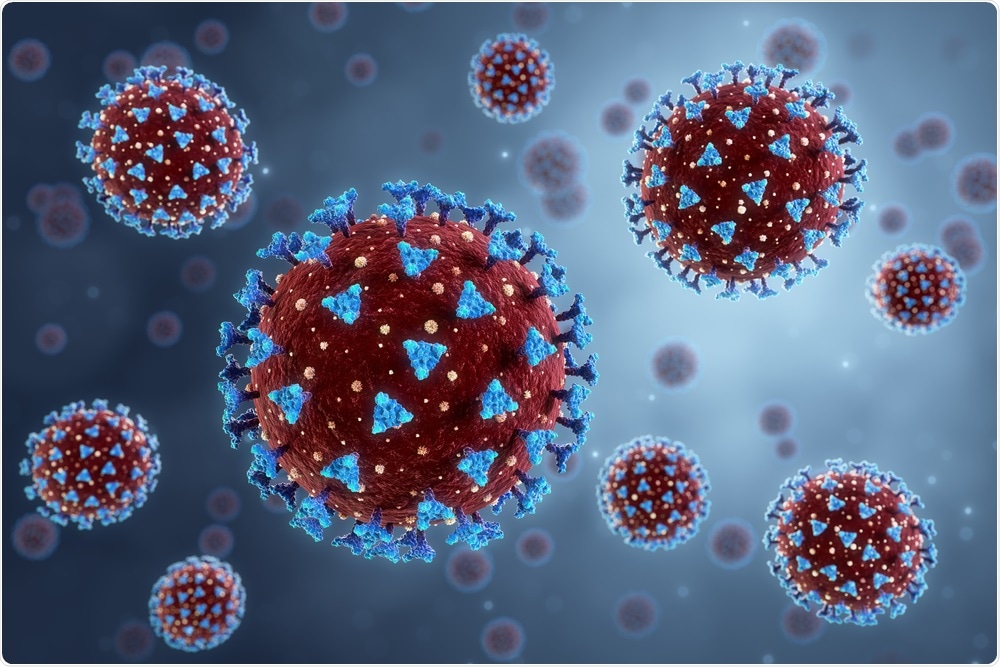An international team of researchers co-headed by the Translational Genomics Research Institute (TGen), an affiliate of the City of Hope, proposes that similar to pouring water atop a wellhead prior to pumping, the airway cells of patients suffering from chronic lung diseases are “primed” for infection by the COVID-19 virus.

SARS-CoV-2. Image Credit: JBArt/Shutterstock.com
This causes more serious symptoms, poorer outcomes, and higher chances of death.
The findings of the research have been published in the journal Nature Communications. The findings elaborate on the genetic changes due to chronic lung disease in the molecular composition of different cells, such as the epithelial cells that line the airways and lungs.
The research explains how these changes facilitate the entry of SARS-CoV-2, the causative agent of COVID-19, into the body, its replication, and the activation of an out-of-control immune response that fills the lungs with fluids usually leads to the need for respirators and lengthy hospitalizations.
The research group employed single-cell RNA sequencing technology to sequence the genetic code of 611,398 cells from different databases, including those with both healthy (control) lungs and those with chronic lung disease. Sequencing and further analysis enabled the team to detect molecular characteristics that might account for worse COVID-19 outcomes.
Our results suggest that patients with chronic lung disease are molecularly primed to be more susceptible to infection by SARS-CoV-2.”
Nicholas Banovich, PhD, Study Senior Author and Associate Professor, Integrated Cancer Genomics Division, The Translational Genomics Research Institute
Dr Banovich is a chief participant in the Human Cell Atlas Lung Biological Network, whose members represent more than 80 institutions globally.
Additionally, male gender, older age, smoking, and co-morbidities like high blood pressure, obesity, and diabetes are all COVID-19 risk factors that are worsened by chronic lung diseases, like Interstitial Lung Disease (ILD), Chronic Obstructive Pulmonary Disease (COPD), and especially Idiopathic Pulmonary Fibrosis (IPF), the progressive stiffening and scarring of the lung tissue.
It was recognized early in the pandemic that patients with chronic lung diseases were at particularly high risk for severe COVID-19, and our goal was to gain insight into the cellular and molecular changes responsible for this.”
Jonathan Kropski, MD, Study Co-Senior Author and Associate Professor, Medicine and Cell and Developmental Biology, Vanderbilt University Medical Center
Changes in lung cells and immune cells
Scientists mainly investigated changes in the AT2 cells, a significant lung epithelial cell type, concentrating on cellular pathways and expression levels of genes linked to COVID-19. They came up with a “viral entry score,” a composite of all genes linked with SARS-CoV-2, and identified higher scores among cells from patients with chronic lung disease.
The researchers also investigated changes in immune cells and identified dysregulated gene expression linked with hyper-inflammation and with sustained cytokine production—both key indications of acute SARS-CoV-2 infection. The cytokine storms in COVID-19 patients release a cascade of immune cells that flood the lungs, resulting in severe organ damage.
The genetic changes in immune cells, especially in specialized white blood cells known as T cells, may diminish the patient’s immune response to viral infection and lead to a higher risk of severe disease and poor outcomes in patients with chronic lung disease. Our data suggest that the immune microenvironment at both the molecular and cellular levels in lungs damaged by chronic diseases may promote severe COVID-19.”
Linh Bui, PhD, Study Lead Author and Post-Doctoral Fellow, Dr Banovich’s Lab, The Translational Genomics Research Institute
Source:
Journal reference:
Bui, L. T., et al. (2021) Chronic lung diseases are associated with gene expression programs favoring SARS-CoV-2 entry and severity. Nature Communications. doi.org/10.1038/s41467-021-24467-0.